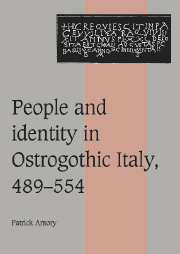Book contents
- Frontmatter
- Contents
- Preface
- List of rulers
- Terminology and vocabulary
- List of abbreviations
- Map of Ostrogothic Italy
- Introduction: Studying the barbarians in late antiquity
- 1 Ethnicity, ethnography and community in the fifth and sixth centuries
- 2 The Ravenna government and ethnographic ideology: from civilitas to bellicositas
- 3 Individual reactions to ideology I: names, language and profession
- 4 Complementary and competing ideals of community: Italy and the Roman Empire
- 5 Individual reactions to ideology II: soldiers, civilians and political allegiance
- 6 Catholic communities and Christian Empire
- 7 Individual reactions to ideology III: Catholics and Arians
- 8 The origin of the Goths and Balkan military culture
- Conclusion
- Appendix 1 The inquiry into Gundila's property: a translation and chronology
- Appendix 2 The Germanic culture construct
- Appendix 3 Archeological and toponymic research on Ostrogothic Italy
- Appendix 4 Dress, hairstyle and military customs
- Prosopographical Appendix: A prosopography of Goths in Italy, 489–554
- Bibliography
- Index
- Cambridge Studies in Medieval Life and Thought Fourth Series
Introduction: Studying the barbarians in late antiquity
Published online by Cambridge University Press: 03 December 2009
- Frontmatter
- Contents
- Preface
- List of rulers
- Terminology and vocabulary
- List of abbreviations
- Map of Ostrogothic Italy
- Introduction: Studying the barbarians in late antiquity
- 1 Ethnicity, ethnography and community in the fifth and sixth centuries
- 2 The Ravenna government and ethnographic ideology: from civilitas to bellicositas
- 3 Individual reactions to ideology I: names, language and profession
- 4 Complementary and competing ideals of community: Italy and the Roman Empire
- 5 Individual reactions to ideology II: soldiers, civilians and political allegiance
- 6 Catholic communities and Christian Empire
- 7 Individual reactions to ideology III: Catholics and Arians
- 8 The origin of the Goths and Balkan military culture
- Conclusion
- Appendix 1 The inquiry into Gundila's property: a translation and chronology
- Appendix 2 The Germanic culture construct
- Appendix 3 Archeological and toponymic research on Ostrogothic Italy
- Appendix 4 Dress, hairstyle and military customs
- Prosopographical Appendix: A prosopography of Goths in Italy, 489–554
- Bibliography
- Index
- Cambridge Studies in Medieval Life and Thought Fourth Series
Summary
We are the prisoners of preconception and periodization. We imbue preconception in images of the barbarians that surround us in school and in popular culture from our earliest childhood. Whether a New Yorker cartoon depicting barbarians in horned helmets and furs confusedly invading a modern office, or Marinetti's fantasies of mustachioed Ostrogoths eating pasta out of holes in the ground with their hands, imagery of barbarian primitivism, violence and, above all, imagery of difference from equally stereotyped Roman behavior, is impossible to avoid. The Nazis celebrated their version of the violent heroism of “Germanic” barbarians, and biker gangs today preserve vestiges of imagery associated with barbarians since the nineteenth century and before.
Despite decades of scholarship on the barbarians, we cannot easily escape these preconceptions, themselves inherited from the literary and artistic depictions of Graeco-Latin ethnography. Theoderic the Great was, alongside his classical education and the enormous subtlety and enlightenment of his propaganda and policy, an unpredictably violent man who murdered his predecessor and one of his courtiers with his own hands. Scholarly commentators have associated Theoderic's violence with his barbarianness, although the Roman Emperor Valentinian III had similarly murdered his general Aetius fifty years earlier.
- Type
- Chapter
- Information
- People and Identity in Ostrogothic Italy, 489–554 , pp. 1 - 12Publisher: Cambridge University PressPrint publication year: 1997



